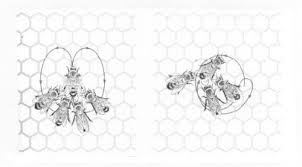Communication among bees can through hearing, touching the antennae, sight (gestures and movements), odors / chemical receptors (pheromones, etc.). Yet bees do not recognize their beekeeper so stay careful.
 Fly or buzz noise varies when the bees are excited, sick, happy or the nut is queenless.
Fly or buzz noise varies when the bees are excited, sick, happy or the nut is queenless.
Young queens who are ready to leave are quacking before leaving the cell. This is answered by the old queen with piping. If the old queen is dead or gone and piping stops, the young queen leaves her cell and kills if necessary the other young queens by biting their cap and stinging them dead. Piping or quacking warns the beekeeper that there is going to be swarmed in the near future.
Bees dance
First detective bees are sent out to look for flowers. They return to the honeycomb surface and begin a dance. The dance provides information about the fragrance of the flower, the taste of the nectar (which remains stuck to the body), the distance and direction to the food source (determined by the dance itself).
There are three types of dances to make clear the other nestmates where the flowers field are.
The round dance
The circle dance shows that the flowers field is in the vicinity (less than 100 meters), but does not indicate the exact direction. The bee makes circular movements in which she changes each direction of rotation. The surrounding bees smell the pollen and so know how the flowers field smells.
The sickle dance
A transition dance for distances between the round dance and the waggle dance. The worker makes a crescent-like curved eight shape. The line that the opening of the sickle divides into two halves, plays the same role as the axis of the waggle dance.
The waggle dance or figure eight dance
For a food source further than 100 meters the bee dances in a figure eight. On the straight part heavy waggle movements are made with the abdomen. The dance rhythm provides information about the distance to the food source: the farther the source, the slower the dance.
The angle of the center line of the 'eight' with the comb corresponds to the angle of the sun with the flight direction to the food source.
